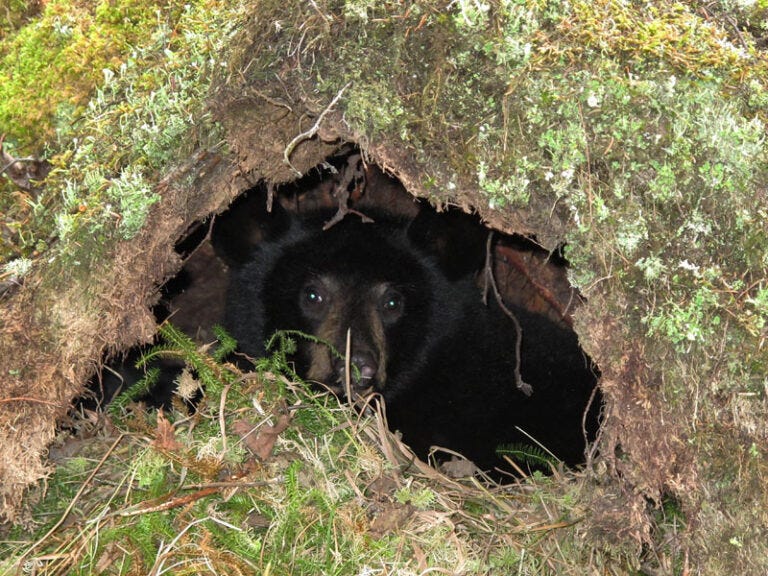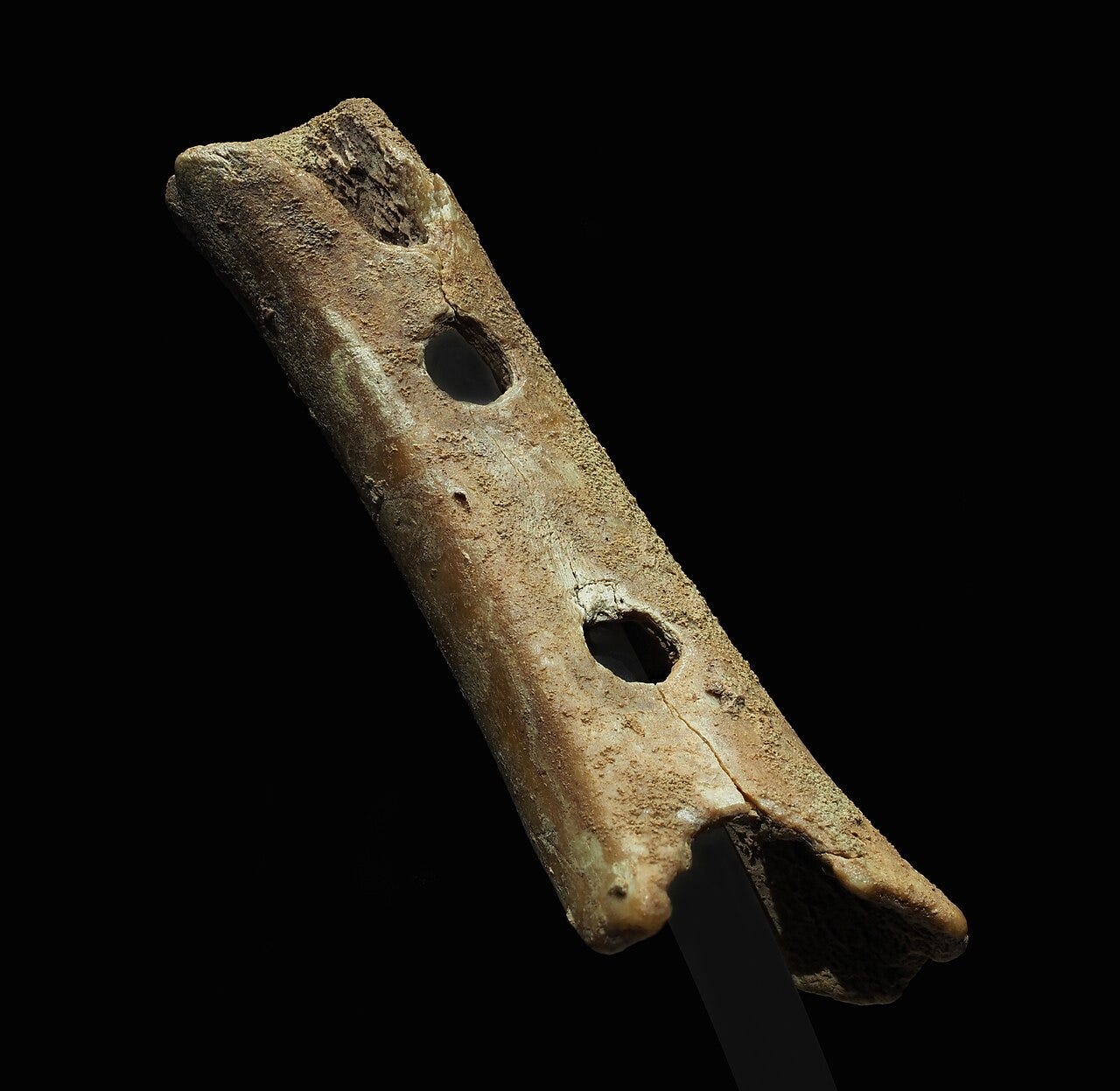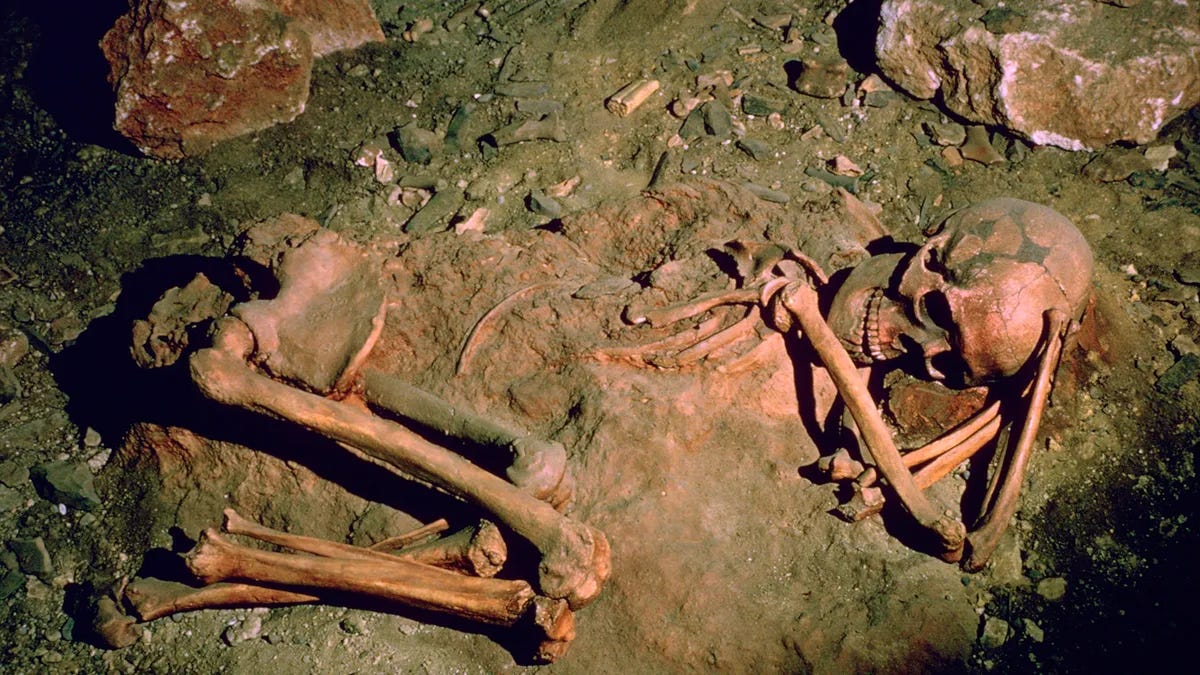The 6 Sacred Symbols of the Neanderthal
Archaeological sites have revealed repeated themes used by our Paleolithic ancestors. Are they enough to define a culture?
Beneath the ancient canopy of prehistory, the symbols of Neanderthal life offer a profound glimpse into the origins of human spirituality and the architecture of our collective myths. The bear and its cave, the skull and femur, and ritualized burial practices make up the foundations of religious thought, intertwining to reveal a tapestry of belief, bridging life, death, and rebirth. These elements—crafted from stone, bone, and pigment—resonate with archetypal power, becoming the seeds from which the myths of later civilizations would grow. In reverence for these six specific symbols, Neanderthals laid the foundation for humanity’s enduring quest to understand existence and transcend mortality.
1-2) The Bear and the Cave
“The mills of time have scattered the records of those ceremonies, but indirect evidence for the bear’s role in the birth of human consciousness is found in archaeological relics, in the residue of belief today in tribal cultures, and in the structure of the language we use.”—Barry Sanders
In the dense forests of prehistory, where survival was a daily wager, the bear loomed large in the imagination of early humans. To the ancient mind, this creature was more than mere prey or predator. It was a mystery—a beast that could stand upright like a man, that seemed to lumber through the woods with an almost friendly face and demeanor, yet possessed strength and speed that no spear could easily conquer. It vanished into the dark recesses of caves, the wombs of the earth, to hibernate, only to reemerge with new cubs in spring—a mimicry of death and rebirth where the mother bear is the bridge between the two. The bear was not merely an animal; it was a symbol, perhaps even a spirit, deserving of reverence.
According to Joseph Campbell, the worship of bears is one of the early signs and evidence of mythological thinking and experience. It could indeed be the earliest, with archaeological examples from Drachenloch, Le Regourdou, and others across Europe repeating similar symbolic themes. Most importantly, it’s persisted throughout the ages in varied forms: mythological archetypes, as the etymological root of place and character names, and the subject of rituals and worship across various cultures of the northern hemisphere.
One might assume “bear worship” is unfamiliar as a concept, relevant perhaps to the anthropology of Neanderthals but not to us—until they consider the ogre, the witch, the giant, the beast. These archetypes often share poor eyesight but an advanced sense of smell. They’re fat and lumbering with a taste for the young who dare to enter their den (the mother bear is tasked with staving off male bears who are prone to infanticide). They come from early man’s relationship with the bear.
The linguistic legacy of the bear underscores its importance. Across cultures, words related to bears often carry connotations of strength, protection, and parenthood. Often not addressed by its “real name” out of reverence, there are hundreds of nicknames across later cultures for the bear, most often associated with the idea of the parent-creator. Names like Arthur, Artio, Artemis, and Atlas—derived from words for "bear", as well as the verb “to bear”—reveal its role as a mythic figure representing the capability to navigate, withstand, transform, and support the weight of the world. Some examples are obvious, such as the constellation Ursa Major, the Great Bear, which is called such by cultures with no historical contact. Others, like “Arctic” which is derived from the Greek word for “north,” literally “the bear’s place,” are less known, but examples abound.
For Neanderthals, evidence of bear skulls and femurs specifically are arranged and ornamented in ways that suggest they were not mere trophies: like the Chugach Eskimos of Alaska, Neanderthals likely believed the soul of a bear resides in its head, hence the skull’s prevalence in ritualistic cave displays. But the parallels are endless: Finns, Celts, Norse, Chinese, Korean, Ainu, various Native American tribes, and all other cultures that share lineage with Neanderthals also share evidence of bear worship.
“I believe we have good grounds for considering that [Celtic] bear worship, in particular, traces an unbroken line of descent from the altars of bear skulls, which Neanderthal built a hundred thousand years earlier.”—Stan Gooch
The connection between the bear’s symbolic death and its rebirth aligns with the Neanderthal understanding of the cave as a sacred space—both tomb and temple. The cave, as both a refuge and a place of ritual, became a sacred womb in its own right—a site where the mysteries of life and death converged. Eventually, the opening of the cave would be reflected in dolmens, burial mounds, and pillared temples. In the ancient mind, the bear emerged as a timeless metaphor for humanity’s belief in renewal and the eternal cycles of existence.
3) The Skull
Symbolic fixation on the skull has centuries of cultural overlap from Neanderthals to modern Eurasians, where it has been an emblem of mortality and memory. While conquering Gaul (modern-day France), the Romans labeled it ‘head-hunting’ among Gallic Celts, estimating it to be a manifestation of their passion for war – a way to collect their defeated enemies (like the notion that bear skulls in Neanderthal caves are hunting trophies). Today the ‘head-hunting’ label is still used to explain missing skulls in ancient burial sites, which was more likely an expression of ancestor worship. As Johannes Maringer reports in The Gods of Prehistoric Man, dispelling the misconceptualized connection of head-hunting to cannibalism:
“The practice of mounting skulls can in all likelihood be regarded as a form of skull cult, by means of which the memory of the departed was cherished and their help and protection sought for the tribe. The artificial enlarging of the foramen magnum, which has been established in so many cases and is usually taken as proof of cannibalism, can be satisfactorily explained in terms of a practice connected with the two-stage burial rite familiar to anthropologists. After decomposition of the soft tissues in the earth, or by exposure of the corpse on a tree or trestle, it only remained, usually, to remove the brain, which decayed more slowly, and the simplest way to do this was to enlarge the opening at the base of the skull.”
But why the skull? If we look back to the belief that the soul of a bear was contained in its skull, we could assume that the soul of man resides in his. Encasing the body’s most powerful and important organ, it is where memories are made and stored, where the senses are gathered, where man’s thoughts, and indeed soul, reside. Thus it is a natural symbol for the man’s soul and memory to live on.
Romans had their own symbolic application for the skull related to remembrance, namely the concept of memento mori—“remember death.” In its stark reminder of human mortality, the skull becomes a gateway to reflection on life’s meaning and the mysteries of existence, a perspective that their Gallic foes shared, and that both likely inherited from a common ancestor.
4) The Femur
Less is speculated about the femur – however Neanderthal and early modern sites suggest they are an equally important symbol. Being the longest and strongest bone in the human body, and the most supportive to the weight of the body, the femur was perhaps a symbol for what carries man through life – his life force. The femur is also the heaviest carrier and most easily accessed receptacle of red marrow, which produces the stem cells essential to the production of blood. To pair it with the skull would be to combine the life force and the mind: simultaneously symbolizing power, balance, mind, memory, and the necessity of their interconnectedness for life to exist.
One of the more famous cultural Neanderthal artifacts is the Divje Babe flute, known as the Neanderthal flute, which is constructed out of the femur of a bear and dated to 50-60,000 years ago, making it humanity’s oldest musical instrument. As Plato said, “Music gives soul to the universe and wings to the mind,” emphasizing the life force quality of the femur and reminding us of the omnipresence of the bear in Neanderthal culture.
For the Ancient Egyptians, whose culture is part of the Neanderthal legacy, the uas-scepter was a ceremonial tool shaped like a femur and associated with the Big Dipper constellation. The Big Dipper is known cross-culturally as the “wagon” or “plough,” i.e. something that holds or carries similarly to the femur—and of course belongs to Ursa Major (Great Bear), the largest constellation in the Northern Hemisphere, known as such also across various cultures that share no historical connection, but do share the Neanderthal as ancestor.
Together, the skull and femurs are a separately recognizable symbol – the “skull and crossbones.” Its exact origin is not known. It is present in and before the Middle Ages in Europe, likely tied to the Roman “memento mori” adage. It resembles the Egyptian crook and flail, which cross-diagonally framed the face on the coffin of Tutankhamun. It has been employed on European military uniforms from Russia to Greece, including the German Totenkopf (‘skull’) symbol adopted by Frederick the Great’s military in the 18th century and a division of the Waffen-SS. Its association with death and injury is now used to label bottles containing toxic substances, but has origins in the burial rites of Neanderthals as an integration of mind and body.
5-6) Burial and Red Ochre
The Neanderthals’ burial practices reflect a profound spiritual understanding of life, death, and renewal. Gravesites offer a wealth of symbolic elements that hint at the belief in reincarnation. Bodies were often interred in fetal position, echoing the posture of the unborn, symbolizing death not as an end but as a return to the womb—a preparation for rebirth. Similarly, cave burials show an intentional alignment with the rising sun, orienting the feet of the dead eastward, also suggesting a belief in the cyclical nature of life, as the sun rises each day, symbolizing renewal and continuity.
Cave burials were central to Neanderthal rituals, with caves functioning as both tombs and temples—a sacred space where life and death converged. These sites, such as those at La Ferrassie and Shanidar, were more than practical shelters; they were places of deep symbolic resonance, embodying the threshold between the earthly and the otherworldly as mentioned alongside the bear symbol.
Grave goods, including tools, animal bones, and ornaments, were often placed alongside the deceased, echoed throughout prehistory and the story of civilization. At Des-Cubierta Cave in Spain, the burial of a child was adorned with antlers and small fires. Le Regourdou is again a telling example, featuring twenty stone boxes surrounding the burial that contained bear bones. These adornments suggest the possibility of ritual, perhaps initiatory, at the caves and sites of burials—an extension of the belief that death is not an end but a transformation.
Red ochre, a mineral pigment ranging from pale yellow to deep red, holds a particularly symbolic role in these burials. Found in numerous Neanderthal graves across Europe and the Middle East, its use has long been interpreted as a substitute for blood, symbolizing life and vitality. At sites like La Chapelle-aux-Saints and Le Moustier, ochre was sprinkled over bodies or arranged around significant grave items. The “Red Lady” of Paviland and the “Fox Lady” of Dolni Vestonice are later examples of this practice, echoing Neanderthal traditions.
The color red, deeply tied to the symbolism of blood, connects the earthly body to the cosmic cycle of birth and rebirth. The application of red ochre in burials transforms these sites into spaces of ritualized renewal, tying the individual’s fate to the rhythms of the natural world. Together with the fetal positioning and solar alignments, ochre affirms the Neanderthal belief in life as a cycle—a sacred journey from one state of existence to the next.
From these symbols, which may seem banal at first glance, the archetypes that make up myth and tradition have grown like limbs off a tree. The bear is the sleeping giant, the ogre, and the witch who feasts on the young. The skull is the cauldron of rebirth, the grail, the music, the memory and wisdom gained from magic talismans. The cave is the otherworld, the underworld, the mysterious, liminal space from which life reincarnates. It is also the dolmen, the tomb, the temple, the place that represents a threshold between this world and another. The sun, the femur, the blood (ochre) all manifest in myriad shapes and sizes in the tales that underpin our collective psyche. There is a sacred continuity that defies the realm of the known—in the depths of the Stone Age, Neanderthals built a castle of the mind that has stood the ultimate test of time.






Fascinating stuff! Thank you. Regarding the skull and crossbones: I seem to recall that the Essenes at Qumran were buried in graves marked with the skull and crossbones. If so, the practice goes back to them at least.
thanks!